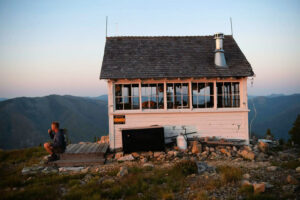
Lots of familiar faces and places, not to mention some impressive photography . . .
If, on a hot, dry day a fire should break out within a certain 300,000-acre patch of northwest Montana, in an expanse of backcountry between the crest of the Whitefish Range and the glacier-carved peaks that hug the Continental Divide, there’s a good chance Leif Haugen will be the first person on Earth to see it.
For the better part of an hour, he might be the only person.
Mr. Haugen has worked for more than half of his 52 years as a fire lookout, scanning the larch and pine wilderness from a one-room mountaintop cabin. Alone most of the time but for his thoughts, his mutt, Ollie, and the occasional crackle of voices on the radio, he is part of a nationwide band of professional watchers who, like lighthouse keepers, stand on solitary guard between civilization and nature’s uncaring whims.
More and more, he stands at another divide, too: between human jobs and automation. As land managers seek new tools to deal with the threat of catastrophic wildfires, which is rising in the West as the planet warms and Americans build more homes near overgrown forests and other vulnerable places, the days of lookouts might be numbered.